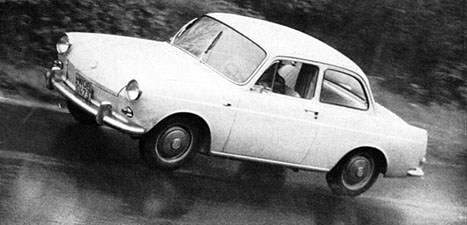VW Type III: History

(VW1500 undergoing testing on the Nurburgring)
As the 1950s were coming to a close and Volkswagen was establishing
itself as a world-class automaker, it became clear that it would need
to introduce a new, larger car to supplement the Beetle, Transporter
and Type I Karmann Ghia. Especially in its home market, VW was beginning
to feel competition from larger, more luxurious American imports.
Volkswagen's answer? The VW 1500, also known as the Type III.
When one of the major buildings at the Wolfsburg factory was damaged
due to fire in the late 1950s, the order came from VW's head honchos
to keep the windows boarded up after repairs were made. It was there
in hiding that the Type III was born in 1959. By the time 1960 drew
to a close, prototypes had been extensively tested and VW began
gearing up for production. At the 1960 Geneva Auto Show, VW's official
position was that there were no new designs in the works! Despite the secrecy, word of a "new" VW had been spreading. Information was sparse and unreliable. The August 1959 edition of "Sports Cars Illustrated" revealed:
|
"Volkswagen is, according to well founded sources, going to build a car somewhat along the lines of the new [Austin] A-40 in addition to the regular line of beetles and transporters."
|
In early 1961, VW officially announced that a new model line was on the way. VW released photos to the press--along with the name "VW1500"--but little else.
Here's one of those photos.
The public's first glimpse of the VW1500.

These first photos created more questions than they answered. Upon close inspection, it was evident that the photos had been retouched. What would the car really look
like? Precious little technical information was released; was the engine in the front or
in the rear? What type of suspension was used?
Rumors abounded about a 4-door model, and a flatter engine with a cooling fan mounted
flat over the top of the engine as in a Corvair. But were all of the rumors true?
One publication, "Motor Trend," did get an early scoop on the new Volkswagen
by catching an unmarked prototype undergoing testing in snow-covered Sweden in early
1961. Note the tape, wires and instrumentation strewn about the car. The white steering wheel was dropped in the production models, as was the chrome strip along
the top edge of the door panels.
Front view.
 Interior.
Interior.
 Rear view.
Rear view.

The 1500
sedan was followed quickly by the 1500 Variant in early 1962.
The Variant looks to all the world like a station wagon (well, it is!),
but VW was already calling one of its Type IIs a station wagon. Furthermore,
to avoid confusing the vehicle's identity with the Plymouth Valiant,
VW marketed the vehicle as the Squareback Sedan in the U.S.
(The state of Georgia called Graham T.'s squareback a "1969 VW
Valiant SB," despite his complaining!)
The public's first glimpse of the VW Variant.

Interestingly, the Type III wasn't officially introduced to the U.S. until late
1965, and the 1500 Sedan (Notchback) was never officially imported to
the U.S. (Tell that to my friend Wally Izumi back home in California,
who bought a '64 Notch brand new from a VW dealer...!) A number
of grey-market 1500s found their way to U.S. shores before their official
intro, but VW of America wasn't equipped to service them until late 1965.
It was a combination of the enormous expense of supplying and training the vast U.S.
dealer network and the hefty price tag for the cars themselves that delayed their
official release in the U.S. VW did send the 1500 to Canada early on. Many of the
Notchback sedans that can be found in the U.S. today made their way in through Canada.
VW sends the new 1500 on tour, Canada 1962.

In 1965, VW added the Fastback (1600TL) to the 1966 model year line up and the new
1600cc engine became available for the existing models. For more details on model-year changes, see the
Special Features
section.
The stylish fastback, last TIII model to join the fleet.

Paralleling the development of the Beetle/Type 14 Karmann Ghia cousins,
VW had Carrozeria Ghia draw up designs for a sporty Type III. A convertible
version of the T34 was unveiled at the 1961 Frankfurt auto show, but
it never saw production. For more T34 info, see
Variations on a Theme in this document,
the
Type 34 Karmann Ghia Registry,
or the
Karmann Ghia home Page.
Type III KG Convertible at Frankfurt Auto Show, 1961

The "regular" VW Type III 1500 convertible was also stillborn.
Only a few were built, one of which is on display at the VW museum in
Germany. Make mine red, please. :-) For more information on Type III convertibles,
visit Big Al.
Type III 1500 Convertible

Notable landmarks in Type III production include a major facelift
for the 1970 models and an option for a fully automatic transmission
beginning in the 1968 model year. Perhaps the most important impact
that the Type III had on the development
of the automobile was the introduction of
electronic fuel injection in the '68s. While fuel injection certainly
existed before this date, it had
never before appeared on a mass-produced "economy" car.
VW ended production of the Type III with the 1973 model year.
Total Type III production is a bit over the 2 million mark, but it's difficult
to get accurate total counts. Aaron Britcher
has provided the most reliable list of production
totals that I've seen.
For details on
technical points and model changes through the years, hop back to the
table of contents and have a look at the
"features" and "mechanical" sections.

